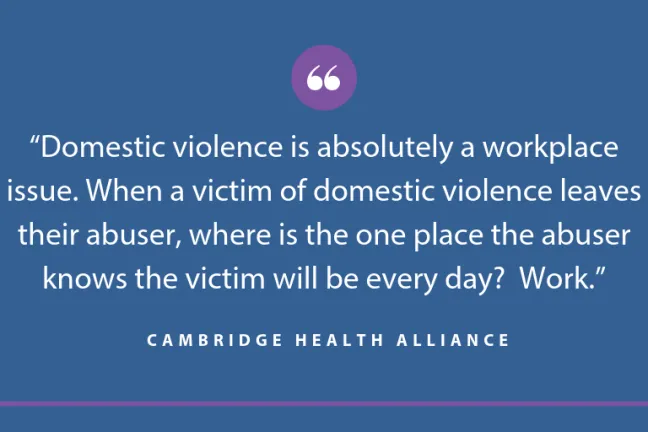This is the fourth in a series of weekly articles throughout October to share information on domestic violence and our work in the County to address it. Read the first article and second article and the third article. Visit our blog or follow us on Twitter and Facebook for updates.
As part of our ongoing series of articles recognizing Domestic Violence Awareness Month, we turn our attention to something we all have in common: our jobs.
We all spend a lot of time thinking about how we can lift up our community. But we also may find ourselves in need of support and assistance. Employees are just as likely as anyone else to experience domestic violence, and that violence often has significant effects on the workplace.
Economic Toll of DV is $9.3 billion
In fact, the Centers for Disease Control and Prevention estimates that the cost of intimate partner physical assault, rape and stalking totaled $9.3 billion in 2017 dollars, many of which were costs associated with healthcare and lost work productivity. Collectively, survivors of violence lose approximately 8 million days of work each year. Survivors miss work time for many reasons, including injuries, emotional and mental trauma, control being exerted by the abusive partner, or the need to attend court proceedings and other related appointments.
Survivors also talk about how the abuse can affect their performance while they are at work. One survivor interviewed in a national report shared, “Our conference room was on the first floor and one wall was all glass. I remember being in a meeting and looking out. There he was in our car just staring at me. I was so nervous. I wasn’t sure what he was going to do.”
3 things you can do at work
With this information in mind, it is easy to begin to understand why domestic violence is a workplace issue. The good news is there are specific things we can do as a workforce to support one another, just as we do for our other community members. If you are experiencing domestic violence or if you are trying to support someone around you who is, you may want to keep these three items in mind:
- Promote your policies: Your place of work may have specific policies related to domestic violence. Read them and promote them.
- Consider organizational culture: Practice trauma-informed and inclusive approaches within your own team. You may want to hang posters that offer resources for survivors, attend training or events to learn more about the issues, and interrupt jokes or statements that trivialize violence or objectify others.
- Support one another’s safety: Pay attention to the well-being of your co-workers. If you suspect abuse may be occurring, privately offer support to them, without pushing them to do any specific thing about it. You may want to watch this two-minute video for an example of how to have this conversation. Be ready to provide information about community resources or to just lend a non-judgmental ear. You may also want to talk through what safety precautions could be considered to reduce impacts of abuse and stalking on the workplace (such as moving the employee’s desk away from a public door or taking their contact information off a public website).
We can strengthen our own workforce through understanding and responding to domestic violence as it impacts the workplace. If you’d like more information, visit the National Resource Center: Workplaces Respond to Domestic & Sexual Violence.
As the Cambridge Health Alliance has written: “Domestic violence is absolutely a workplace issue. When a victim of domestic violence leaves their abuser, where is the one place the abuser knows the victim will be every day? Work.”

